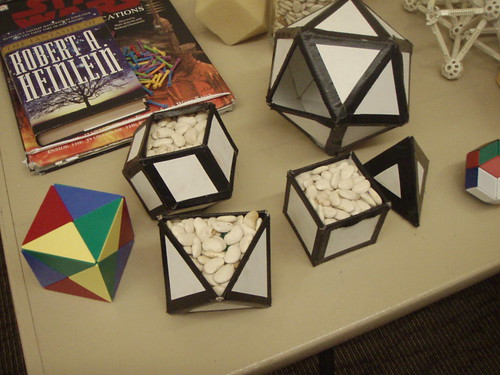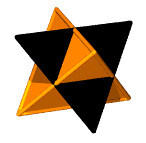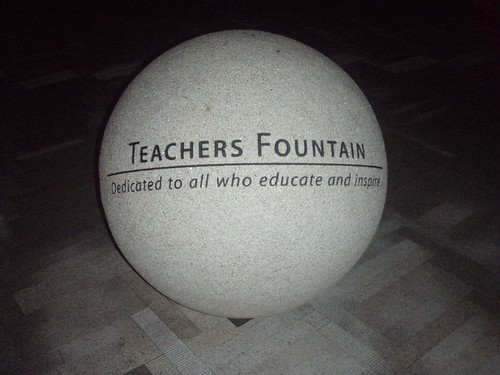Art students come to school eager to draw, paint and sculpt nudes, with rented subjects, friends, or each other, so my class is a relatively boring affair by many accounts, with all its skeletal outlines of duals and what-not. But lets remember it's not either / or and we wouldn't have flesh without bones to hang it on.
The bones of which I'm speaking are the metaphysical rods of the IVM and XYZ, two space-filling scaffoldings we'd like to relate smoothly. To that end, we isolate the quintessential cube of Cartesian science and cast it next to the IVM's home base tetrahedron, the edge-lengths of which likewise define the octahedron voids in this matrix.
I'll abbreviate making that bridge as I've done extended presentations on just that topic in other venues, and go straight to the dual of said home base tetrahedron. I color code the two intersecting tetrahedrons black and orange, which goes with Princeton, tigers, Halloween, OSU and no doubt many other worthy themes.
One needs to start somewhere with the coloring, or not. I've gone with green for cube, red for octahedron, and blue for rhombic dodecahedron, of volumes 3, 4 and 6 respectively. Yellow for the cuboctahedron (20). Then in my accompanying text and symbolic formulae, I'm able to use matching coloration for the font.
The aforementioned four-fold crystalline shapes then need to work in some other prime numbers, most notably more 5, which we accomplish visually with a Jitterbug Transformation (JT). The cuboctahedral and icosahedral number sequences are the same, thanks to the ball-count-preserving JT, possible with any hollow layer.
The minimalist JT provides a back-bone transformation for the canonical suite, out to the two-frequency Cube of volume 24. Once "frequency" is established we're ready for the space-time realm, a place of energy vectors (inertial flows). Pre-frequency is more Platonic.
Art students don't need the whole of Physics, with its energy conservation, spelled out there and then. More of that comes in film school, wherein a "lights, camera, action frame" pd (in Planck units, a momentum for a distance) goes by in a time (pd/t = E = energy buckets), at a frame rate (E/t = power).
Get them to electric light and paint pigments, RGB, CYMK, and you're well on your way to that art degree. Maxwell's Equations might be in some optional reading section?
In making these notes, I'm not saying we shouldn't do Physics when introducing the concentric hierarchy. Probably the classic set of opening moves is through icosahedral symmetry to the micro-architecture of the viral capsomeres, then on to buckyballs, nanotubes and graphene (diamond, graphite...).
The sequence 1, 12, 42, 92... gets in early, with the thought that "shape" reflects the prime number composition of the first term (2PN**2 + 2), whereas the second term (+2) suggests polar pairing, axial spin. The first term diverges as a 2nd power, showing surface growth, which integrates (accumulates) as a 3rd power volume count (1, 13, 55, 147...).
They're all expected to know XYZ, sometimes known as Fermatian coordinates as well. Next to those, the Chakovian coordinate system (Wikipedia: Quadray coordinates) makes a brief appearance, so obscure, so esoteric, so underground.
Artists, including comic book artists, lap this stuff up, so they might sometimes impress their math major friends with something somewhat surprising. Artists like to jump into the limelight and perform feats. Many architects are likewise into show business.
The bones of which I'm speaking are the metaphysical rods of the IVM and XYZ, two space-filling scaffoldings we'd like to relate smoothly. To that end, we isolate the quintessential cube of Cartesian science and cast it next to the IVM's home base tetrahedron, the edge-lengths of which likewise define the octahedron voids in this matrix.
I'll abbreviate making that bridge as I've done extended presentations on just that topic in other venues, and go straight to the dual of said home base tetrahedron. I color code the two intersecting tetrahedrons black and orange, which goes with Princeton, tigers, Halloween, OSU and no doubt many other worthy themes.
One needs to start somewhere with the coloring, or not. I've gone with green for cube, red for octahedron, and blue for rhombic dodecahedron, of volumes 3, 4 and 6 respectively. Yellow for the cuboctahedron (20). Then in my accompanying text and symbolic formulae, I'm able to use matching coloration for the font.
The aforementioned four-fold crystalline shapes then need to work in some other prime numbers, most notably more 5, which we accomplish visually with a Jitterbug Transformation (JT). The cuboctahedral and icosahedral number sequences are the same, thanks to the ball-count-preserving JT, possible with any hollow layer.
The minimalist JT provides a back-bone transformation for the canonical suite, out to the two-frequency Cube of volume 24. Once "frequency" is established we're ready for the space-time realm, a place of energy vectors (inertial flows). Pre-frequency is more Platonic.
Art students don't need the whole of Physics, with its energy conservation, spelled out there and then. More of that comes in film school, wherein a "lights, camera, action frame" pd (in Planck units, a momentum for a distance) goes by in a time (pd/t = E = energy buckets), at a frame rate (E/t = power).
Get them to electric light and paint pigments, RGB, CYMK, and you're well on your way to that art degree. Maxwell's Equations might be in some optional reading section?
In making these notes, I'm not saying we shouldn't do Physics when introducing the concentric hierarchy. Probably the classic set of opening moves is through icosahedral symmetry to the micro-architecture of the viral capsomeres, then on to buckyballs, nanotubes and graphene (diamond, graphite...).
The sequence 1, 12, 42, 92... gets in early, with the thought that "shape" reflects the prime number composition of the first term (2PN**2 + 2), whereas the second term (+2) suggests polar pairing, axial spin. The first term diverges as a 2nd power, showing surface growth, which integrates (accumulates) as a 3rd power volume count (1, 13, 55, 147...).
They're all expected to know XYZ, sometimes known as Fermatian coordinates as well. Next to those, the Chakovian coordinate system (Wikipedia: Quadray coordinates) makes a brief appearance, so obscure, so esoteric, so underground.
Artists, including comic book artists, lap this stuff up, so they might sometimes impress their math major friends with something somewhat surprising. Artists like to jump into the limelight and perform feats. Many architects are likewise into show business.



